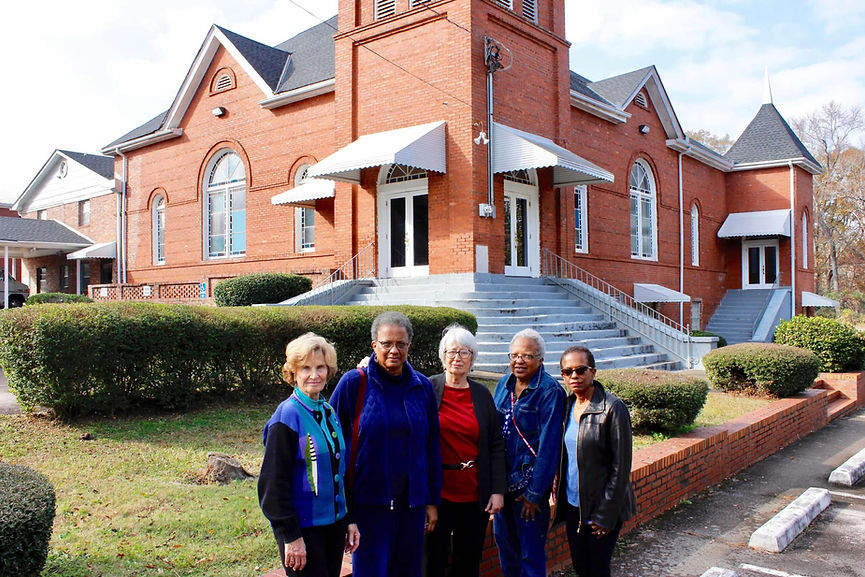
Loduska “Dusky” Crutchfield, John Moore, Burrell Hardaway, Eugene Harrington
were lynched on January 22, 1912
As for Dusky Crutchfield, the mob had a plan…You tell us who done it and we’ll put you on the next train out of here…With only a pointed finger, she could save her life…All she had left was her word and what she took to God…She did not pause to think about it…she would not go to God with the blood of black men on her hands. “Pull the rope, white man,” she said.
– “The Family Tree: A Lynching in Georgia”
Held for questioning, never formally charged, they were victims of a conspiracy theory without evidence or witness, and the reasons for this were never discussed. These four innocent people were friends and neighbors who worshipped at St. James AME Church community in the Mountain Hill section of Harris County. One was the pastor; two were deacons as was Dusky Crutchfield’s husband. They had all lived in Harris County for all or most of their lives and had large extended families here. The three men were self-employed farmers. All four could read and write. Three of the men had long-term marriages; one was widowed and engaged. Some engaged with White neighbors and cousins in the making and selling of moonshine. None had criminal records.
Loduska (“Dusky”) Hogg Crutchfield was born in June 1873 in Troup County. She was 38 years old when she died. She had been married 17 years to James Crutchfield. At the time she was murdered, she cared for two adopted children, George, 17, and Lizzie, 13. She was one of the few Black women in the area at the time who could read and write. She and her husband were self-employed farmers who lived in Mountain Hill. Like many of the Mountain Hill residents, Black and White, they made and sold moonshine. James Crutchfield was a deacon at St. James AME Church. They lived next door to John Moore at the intersection of Antioch Rd. and Old Ford Rd.
John Moore was born in Harris County in 1887. He was 25 years old, widowed, childless and living next door to his mother and sister when he died. He lived two houses away from the Crutchfields. A self-employed farmer, who rented his land and was able to read and write, he was engaged to the daughter of Eugene Harrington. John’s mother, Lula, was the niece of the sheriff’s uncle, who had at least five children by his only enslaved person, Jane Moore. He and his extended family had long-term associations, including blood kinship, with the sheriff’s and deputy sheriff’s Hadley-Moore families.
Burrell Hardaway was the preacher at St. James AME in Mountain Hill, as well as a farmer. Born in 1881, he was 31 when he was put to death by the mob. He had been married 11 years to Pone, who was 27. They had five children: John, 10, Lucy, 8, Henry 6, Mike 4, and Liza, 2. Rev. Hardaway was known as a courageous minister who preached against the rape and abuse of Black girls and women by local white men.
Eugene Harrington, a farmer, was born in 1872, and died at 40. He and his wife, Mary, lived and farmed on State Rd. near Mtn. Hill Rd. and had one daughter, Burtha Lee, who was 14 and attending school when her father was killed. Harrington was a deacon at Hardaway’s church. Burtha Lee was being frightened and pursued by the sheriff’s nephew, an older white man.
Left behind were eight children, two wives, one husband, as well as countless parents, siblings, aunts, uncles and cousins. Relatives of John Moore fled to Illinois. Relatives and neighbors of victims fled to surrounding counties. Little is known of how many Black Harris Countians were adversely affected by this heinous crime. To a different degree, many white people were also adversely affected.
With fear permeating the atmosphere, only one body was claimed by friends or family. Three of the victims were buried together somewhere near the lynching at Friendship Baptist Church. No gravesites have been identified.
Sometime in the 1930’s, a white man whose name has not been discovered, confessed on his death bed to the murder of the sheriff’s nephew, the event that led to the lynching.
They lynched them on the grounds of the Black Friendship Baptist Church. You can’t get any more horrific than lynching people on the Black church grounds. It wasn’t just the four victims, it was an entire Black community that was absolutely terrorized by this event.”– Jackie Irvine, John Moore’s cousin
December 2016 Soil Project for the 1912 Victims
In 2015, the Equal Justice Initiative began working with communities across the country to commemorate and recognize the traumatic era of racial terror by collecting soil from lynching sites. The Community Soil Collection Project provides a tangible way for community members to confront the legacy of racial terror of lynchings and to memorialize the African American victims whose lives were lost and the communities impacted by such violence.
In December 2016 descendants of 1912 lynching victim John Moore and descendants of law officers and mob members responsible, along with Father Jeff Jackson of St. Nicholas Episcopal Church, gathered soil and spoke words of grief, hope and justice near the lynching site.
They travelled together to Equal Justice Initiative in Montgomery where they stored the soil in jars and presented them to Bryan Stevenson, executive director. The jars, labeled with the victims’ names, are now on exhibit at EJI.
Soil collections for George Nelson, Nelson Jordan and Arthur McCauly to be announced.
-
New York Times article: “Their Ancestors Were on Opposite Sides of a Lynching. Now, They’re Friends”
-
Atlanta Journal Constitution article by Karen Branan: “Harris County, 1912: The lynchings in my family’s history”
-
Zinn Education Project Jan. 22, 1912: Hamilton, Georgia Lynching

Newspaper article about 1912 lynchings
Columbus Ledger questions guilt of 1912 victims

Atlanta Constitution article about 1912 lynchings

